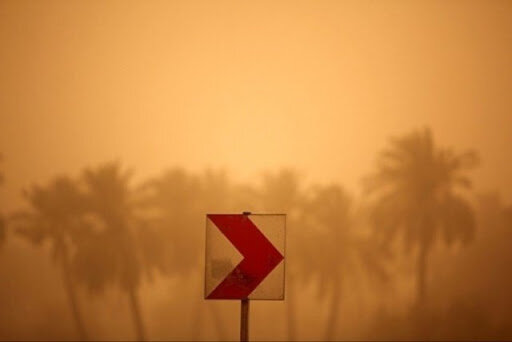Tehran to host regional meeting on SDSs

TEHRAN – A meeting will be held in Tehran on Monday with representatives of neighboring countries in attendance to develop a plan for dealing with sand and dust storms (SDSs) in the region.
The Ministry of Foreign Affairs will host ambassadors of Iraq, Syria, Jordan, Kuwait, Oman, Afghanistan, and Pakistan, as well as representatives of Tehran-based international organizations, ISNA reported.
In order to advance the goals of controlling and managing dust hotspots in the region, countries that have had successful experiences in this field, such as China, India, etc., have also been invited to attend the meeting.
In addition to developing a regional action plan to combat dust, we seek to establish a center in Iran to deal with sand and dust storms in West Asia.
Since the past few years, southern and western provinces of the country are frequently hit by sand and dust storms, as well as drought and even destructive floods, which is caused by both internal and external hotpots. Major external SDSs sources are Syria, Saudi Arabia, and Iraq.
In fact, Iran has been repeatedly exposed to SDSs due to its presence in the arid and semi-arid part of the world, so that in 2006-2007, the dust storms originating in Iraq and Syria affected Iran, haunting a wide area of the country so that it reached the central areas and southern slopes of Alborz and also included Tehran.
Consumption, changing the pattern of cultivation, and climate change have increased the negative effects of this phenomenon.
The SDSs hotspots in other countries stretch to 330 million hectares, with an average of 150 million tons of dust generation per year, Ali Mohammad Tahmasebi, head of the national working group for SDSs mitigation, said.
Pointing out that over the past three years, the government has spent about $370 million from the National Development Fund on fighting sand and dust storms, he noted that therefore, the DOE has gained good experience in managing domestic dust sources and, accordingly, has conducted follow-ups to manage external SDSs hotspots.
He went on to say that important dust sources in the country’s provinces estimated at 34.6 million hectares, with an average amount of 4.24 million tons of dust per year, of which 122.7 kilograms of dust per hectare is raised annually.
He also said that 15 to 20 percent of these hotspots are highly active and 25 percent of which are moderately active, about 60 percent of the sources are slightly active, “so we should definitely be alert to SDSs hotspots with low dust generation to prevent them from the intensity.”
In response to a question saying that have we been successful in managing the internal dust sources far, he explained that “In my point of view, a dust source can never be completely eradicated. Therefore, we must take measures to bring the amount of dust to an acceptable level.”
Pointing out that during the last three years, we have been successful in managing dust centers in the country, he stated the intensity and frequency of sand and dust storms in Khuzestan province have declined significantly. Currently, the vegetation covers in the southeast of Ahvaz is more than 40 percent in over 200,000 hectares.
“If our actions are only to control dust centers inside the country and leave foreign sources, we will not achieve success,” he concluded.
According to the World Metrological Organization, sand and dust storms usually occur when strong winds lift large amounts of sand and dust from bare, dry soils into the atmosphere. Over the last decade, scientists have come to realize the impacts on climate, human health, the environment, and many socio-economic sectors.
How to mitigate the effects of SDSs
According to EcoMENA, sand and dust storms cause significant negative impacts on society, economy, and environment at local, regional, and global scales. There are three key factors responsible for the generation of sand and dust storms – strong wind, lack of vegetation, and absence of rainfall. The environmental and health hazards of such storms cannot be reduced permanently, however, its impact can be reduced by taking appropriate measures.
As the dust cloud rises, it reduces horizontal visibility which can impact human life in many ways. The fine suspended particles also contain contaminants, bacteria, pollens, which cause negative health impacts such as allergies and respiratory diseases. Dust also carries airborne pollutants such as toxins, heavy metals, salt, sulfur, pesticides, etc. which cause significant health impacts when people inhale the contaminated dust. Dust can corrode buildings and other built infrastructure as it contains a high level of salts.
The effects of sand and dust storms can be reduced by using a number of health and safety measures and environmental control strategies. Large-scale sand and dust storms are generally natural phenomena and it may not be always practicable to prevent it happening. However, control measures can be taken to reduce their impacts. Localized small-scale dust emission due to human-induced activities can be reduced by using temporary mechanical methods such as concrete barrier, mulching, tree buffer, etc.
Taking appropriate control of dust raising factors such as increasing the vegetation cover where possible can help in the stabilization of the soil, sand dunes, and form windbreaks. Additionally, the use of native plants and trees as the buffer can reduce wind velocity, and sand drifts at the same increase the soil moisture. Designing buildings appropriately and conduct air infiltration testing during building commissioning can also help the adverse effects of sand and dust storm.
FB/MG
Leave a Comment